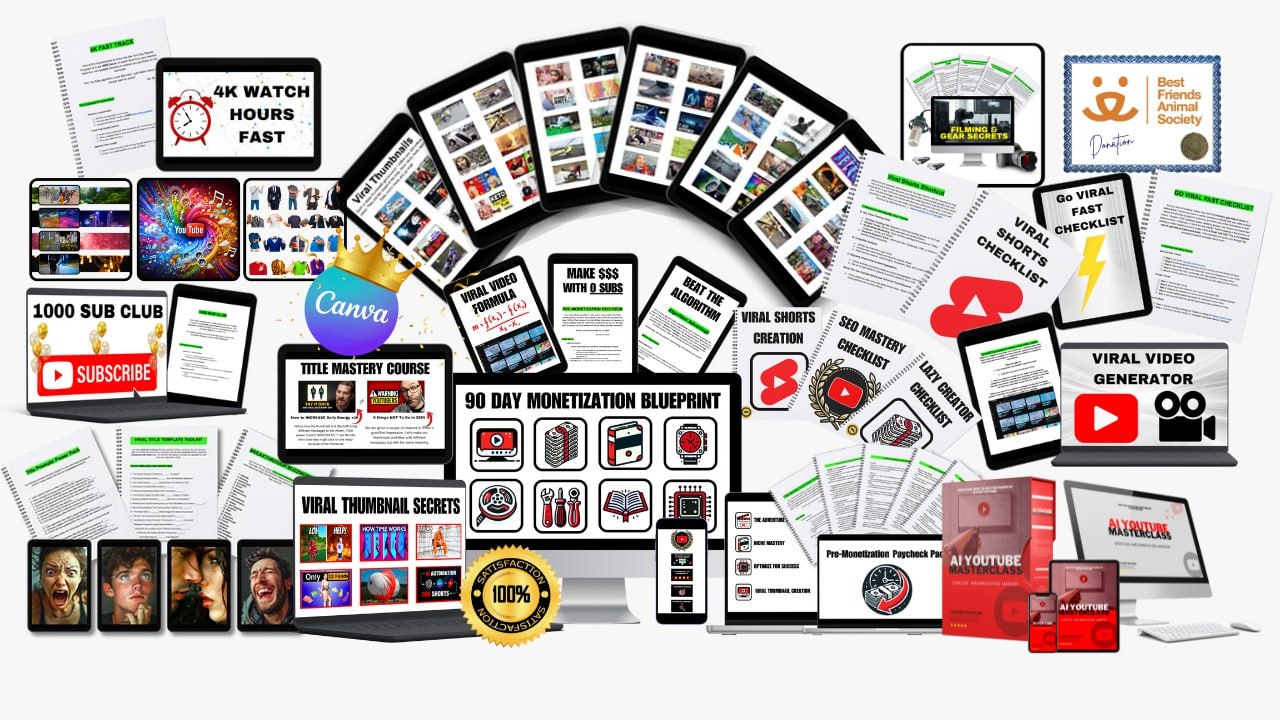
YouTube has become one of the most lucrative platforms for content creators, offering multiple avenues for monetization. However, achieving monetization requires a strategic approach, consistency, and a deep understanding of the platform’s algorithms and audience preferences. This 60-day blueprint will guide you through the process of setting up, optimizing, and growing your YouTube channel to meet the monetization requirements and start earning revenue.
Day 1-10: Laying the Foundation
1. Define Your Niche and Target Audience
- Choose a niche that aligns with your passion, expertise, and market demand. Popular niches include tech reviews, personal finance, fitness, education, and entertainment.
- Research your target audience’s demographics, interests, and pain points. Use tools like Google Trends, TubeBuddy, or VidIQ to identify trending topics.
2. Set Up Your YouTube Channel
- Create a Google account if you don’t already have one.
- Set up your YouTube channel with a professional name, logo, and banner. Ensure your branding is consistent across all platforms.
- Write a compelling channel description that clearly states what your channel is about and who it’s for.
3. Understand YouTube Monetization Requirements
- To qualify for the YouTube Partner Program (YPP), you need:
- 1,000 subscribers.
- 4,000 watch hours in the past 12 months OR 10 million Shorts views in the last 90 days.
- Familiarize yourself with YouTube’s policies, including community guidelines and copyright rules.
4. Invest in Basic Equipment
- You don’t need expensive gear to start. A decent camera, microphone, and lighting setup will suffice.
- Use free or affordable video editing software like DaVinci Resolve or Canva for editing.
5. Plan Your Content Strategy
- Create a content calendar outlining the types of videos you’ll publish (e.g., tutorials, reviews, vlogs).
- Aim for a mix of evergreen content (timeless topics) and trending content to attract both long-term and immediate traffic.
Day 11-30: Building Momentum
6. Publish High-Quality Content Consistently
- Upload your first video and aim to publish at least 2-3 videos per week.
- Focus on creating value-driven content that solves problems, entertains, or educates your audience.
- Keep videos concise and engaging, ideally between 7-15 minutes for long-form content.
7. Optimize Videos for SEO
- Use keyword research tools like TubeBuddy or VidIQ to find high-volume, low-competition keywords.
- Write compelling titles with keywords (e.g., “10 Tips to Lose Weight Fast in 2024”).
- Craft detailed video descriptions with relevant keywords and links to your social media or website.
- Add tags and hashtags to improve discoverability.
8. Design Eye-Catching Thumbnails
- Use tools like Canva or Photoshop to create custom thumbnails that are visually appealing and click-worthy.
- Include bold text, contrasting colors, and your face or key visuals to grab attention.
9. Engage with Your Audience
- Respond to comments on your videos to build a community.
- Ask questions in your videos to encourage viewers to leave comments.
- Use polls, cards, and end screens to increase engagement.
10. Promote Your Videos
- Share your videos on social media platforms like Instagram, Twitter, and Facebook.
- Collaborate with other creators in your niche to cross-promote content.
- Join relevant online communities (e.g., Reddit, Facebook groups) and share your videos where appropriate.
Day 31-45: Scaling Your Channel
11. Analyze Your Performance
- Use YouTube Analytics to track metrics like watch time, click-through rate (CTR), and audience retention.
- Identify your best-performing videos and create more content around those topics.
12. Experiment with Different Content Formats
- Try creating YouTube Shorts to tap into the growing Shorts audience.
- Host live streams to engage with your audience in real-time.
- Test different video lengths and styles to see what resonates most with your viewers.
13. Monetize Beyond Ad Revenue
- Enable Super Chats and Super Stickers for live streams.
- Set up a Patreon or membership program to offer exclusive content to paying subscribers.
- Promote affiliate products or your own merchandise in your videos.
14. Run a Giveaway or Contest
- Host a giveaway to incentivize viewers to subscribe, like, and share your videos.
- Ensure the prize is relevant to your niche to attract the right audience.
15. Network with Other Creators
- Reach out to creators in your niche for collaborations or shoutouts.
- Attend virtual or in-person events to build relationships within the YouTube community.
Day 46-60: Maximizing Revenue and Growth
16. Apply for the YouTube Partner Program
- Once you meet the eligibility criteria (1,000 subscribers and 4,000 watch hours or 10 million Shorts views), apply for YPP.
- Set up an AdSense account to start earning ad revenue.
17. Optimize for Higher CPMs
- Create content around high-CPM niches like finance, tech, or education.
- Avoid demonetized topics like controversial or sensitive subjects.
18. Diversify Your Income Streams
- Offer sponsored content to brands in your niche.
- Create and sell digital products like eBooks, courses, or templates.
- Use affiliate marketing to earn commissions from product recommendations.
19. Leverage Email Marketing
- Build an email list by offering a free lead magnet (e.g., a checklist or guide) in exchange for viewers’ email addresses.
- Use email marketing to promote new videos, products, or services.
20. Stay Consistent and Adapt
- Continue publishing high-quality content consistently.
- Stay updated on YouTube algorithm changes and adapt your strategy accordingly.
- Celebrate milestones and keep your audience engaged with behind-the-scenes content or updates.
